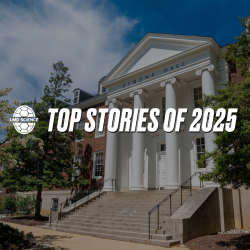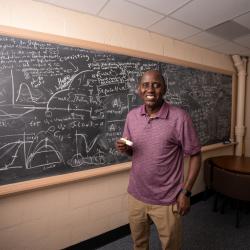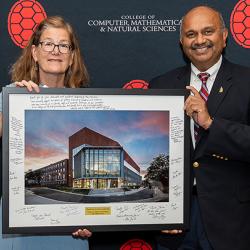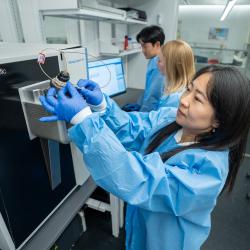UMD Junior Awarded Prestigious Astronaut Scholarship
Mathematics and chemistry dual-degree student Benjamin Raufman’s journey from high school lab work to national recognition highlights the power of early research experience.

Benjamin Raufman, a junior mathematics and chemistry dual-degree student at the University of Maryland, has been selected as a 2025 Astronaut Scholar by the Astronaut Scholarship Foundation. He is one of 74 undergraduate students from 51 institutions nationwide selected this year.
The prestigious award, funded by former astronauts and established by NASA’s Mercury mission veterans, provides financial support and networking opportunities to promising junior and senior college STEM students across the country. While the scholarship was founded by space pioneers, it recognizes excellence in all scientific disciplines. As an Astronaut Scholar, Raufman will receive an all-expenses-paid trip to Houston, Texas, for the foundation’s Innovators Gala; opportunities to present his research at the Scholar Technical Conference; and mentoring from astronauts, scholars and chief executives across the country.
This recognition follows Raufman’s Barry Goldwater Scholarship, which he received earlier this year.
“I’m extremely grateful to the Astronaut Scholarship Foundation, UMD’s National Scholarship Office and to all the mentors who have supported me along the way,” Raufman said. “It was humbling, to say the least, to see the achievements of some of the other incredible students that have received the award. I hope I can live up to what this award is meant to be for.”
An early start, a lasting impact
Raufman’s journey began at Towson High School’s Science Bowl club in 2019, when a fellow student told him about research opportunities at Towson University.
“I’ve always liked STEM, so I thought to myself that it would be great to see what it all looks like in a professional setting,” Raufman recalled.
For Raufman, what started with simple curiosity soon led to a defining experience. As a high school sophomore, Raufman signed up to work with Mary Sajini Devadas, an associate professor of chemistry at Towson University. When the COVID-19 pandemic hit just after he joined her lab, Devadas continued mentoring him remotely.
“I met with her weekly to talk about what was going on at the lab and she’d send me papers online,” Raufman explained. “So, I started to learn the research before I could actually work in a lab.”
When the lab eventually reopened, Raufman’s virtual high school schedule created an unexpected opportunity. Because he could attend his regular high school classes online, he was able to spend much of his junior year working independently in Devadas’ lab.
He primarily focused on synthesizing and characterizing gold nanoclusters—tiny particles with unique optical and electronic properties that hold promise for biomedical applications. Despite numerous challenges and failed experiments in his early attempts, Raufman’s persistence eventually paid off. His breakthrough research on platinum-doped gold-11 nanoclusters resulted in a first-author publication—a rare achievement for an undergraduate.
“Being able to do real research and publish a paper early on let me get a running start for college,” Raufman said. “A lot of what I learned was extremely useful for when I got to UMD and I was able to build on my past experiences.”
Bridging lab and clinic
Since then, Raufman has expanded his research repertoire, adding an additional focus on patient-focused medical research. He currently works with UMD Chemical and Biomolecular Engineering Professor Srinivasa Raghavan on two projects. The first involves developing biologically derived hemostatic agents from materials like chitosan (a material naturally found in the exoskeletons of shellfish) that can stop bleeding during surgery or medical emergencies. For the second project, he studies how certain polymers can separate into different phases when mixed together, research that may lead to additional insights into how cells can organize themselves.
“Ben is one of the best undergraduate researchers to have worked in my lab in my 24 years at UMD. He’s been involved in multiple projects with my group, notably creating granules that stop bleeding,” Raghavan said. “He is incredibly mature and very passionate about medical research and will go far in the field.”
During the last few summers, Raufman interned at the University of Maryland School of Medicine, examining circular RNAs and their role in regenerating intestinal tissue and other medical conditions. This research led to a co-authored paper published in 2024. This summer, Raufman will investigate lipids involved in gene delivery and mRNA vaccines at the University of Texas Southwestern Medical Center in Dallas.
Raufman said his training at UMD and Towson also led to his interest in studying PROTACs, molecules that allow scientists to pinpoint and remove specific proteins. This emerging field of drug development has implications for fighting disease on a molecular level, potentially avoiding unwanted mutations and side effects that might be found in more traditional therapeutic approaches.
“For the longest time, scientists have considered a large portion of proteins in the human body to be undruggable and untreatable,” he explained. “But with all these new advancements in all these different fields, it looks like we’ll be able to have more control over protein expression in the body than we ever thought possible. That means we’ll have more methods to treat diseases that doctors can’t currently cure.”
Raufman’s experiences in diverse laboratories and fields of science lay the foundation for his goal to pursue an M.D. and Ph.D. in chemical biology. He hopes to apply chemistry techniques to biological systems for drug design, translating his research experience directly to patient care.
“Individual fields of research are really blending together. Chemistry, physics, biology— they’re all converging to drive biomedical research,” Raufman said. “It’s a great benefit to have a group of people trained in different fields work together to solve problems. You get to see unique perspectives from them and contribute your own unique experiences to a better, more well-rounded solution.”
###
UMD’s participation in the Astronaut Scholarship program, a by-institution-invitation-only award competition, is led by the A. James Clark School of Engineering. Eligibility extends across all STEM fields.







